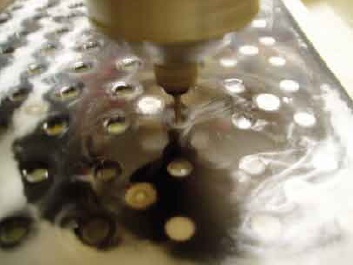
‘Ancient technique in a brand new package’ is a way of describing the latest production methods employed at ‘Lise Aagaard Copenhagen’.
The road from idea to finished product can be paved with many difficulties, but the technique is the constant that makes otherwise unthinkable combinations of design, material and detail in the Trollbeads possible.
The Trollbeads are handmade in nature’s own materials – silver, gold, pearls, jewels and glass. Some of the designs are instruments.
When the original model is in place, a ‘master’ is cast. This is the basis for all the future Trollbeads of this model that will eventually end up on the customer’s arm. For this process an exceptional technique is used – the so-called ‘cire perdu’ or ‘lost
wax’ method. With this you can make copies from wax to precious metals so precise that even the smallest crack is reproduced.
This technique is 3,000 years old and has been used by Indian goldsmiths travelling from town to town with their crucible, by Chinese smiths casting tea-pots and by our own smiths casting the famous lures. This was quite a feat in those days when you consider the difficulty and importance of keeping a steady temperature in order to get a good result. A problem that has been overcome by today’s smiths – well, almost!
When the new silver- or gold-Trollbead is out of the furnace it must be refurbished.
Any cracks must be smoothed out and before its final polish the bead’s natural oxidation is accelerated. In sterling silver there will always be a certain amount of copper; this copper will react with the oxygen in the air, creating dark shadows
unless it is painstakingly polished on a regular basis. In cracks and pits the silver will thus remain black and help emphasize detail, depth and dynamics in the finished Trollbead.
The majority of designers prefer working with 18 carat gold. One of the explanations could be that gold does not oxidize naturally but keeps its shining luster even under extreme conditions. Even if you leave it on the ocean floor for centuries it will keep on sparkling and glittering. Gold’s incredible durability opens up numerous design possibilities, especially when combining it with the oxidizing silver.
Most Trollbeads are, however, made entirely out of either silver or gold. Some are encrusted with precious stones – another variant in the Trollbeads’ broad 
spectrum of designs. The stones add color, character and a traditional feel of jewellery.
Natural pearls demand a special technique. The pearl is a traditional and 
well-known piece of jewellery, but in order to be included in the Trollbead collection, and be put on a chain, it has to be lined with silver. The freshwater pearl, however, has a very hard surface making the drilling of the hole a demanding task. Drilling a tiny hole in a pearl is one thing, drilling a hole large enough to accommodate a chain is an entirely different matter – without cracking or breaking the pearl, that is. The solution was found with yet another member of the Nielsen/Aagaard family, the brother Per Nielsen. Per Nielsen is the engineer of the group and he designed a robot for the sole purpose of drilling holes in pearls, a job that has now been fully automated.
The glass beads grant an opportunity to play around with colors. The beads are made with glass rods, primarily the finest Italian Murano glass, but also with American and Czech glass types. The various types of glass have differences in density, some are subdued others are clear. The colors will react to the different
Some Trollbeads are created directly over open flame – namely the biggest seller in the family – the glass beads. Glass is in many ways different to metal to work with. Glass melts at 800 centigrade whereas metal melts at 500 centigrade. Glass is softer while it is being processed and much harder in its finished form, hard enough, in fact, to wear out the bracelet if not lined with silver on the inside. If this is done properly it is almost impossible to break the finished bead.
The glass beads grant an opportunity to play around with colors. The beads are made with glass rods, primarily the finest Italian Murano glass, but also with American and Czech glass types. The various types of glass have differences in density, some are subdued others are clear. The colors will react to the different
types of glass used and some colors will stand out where others will become more mellow and subdued. Because of this it takes great skill and knowledge of glass in order to make the glass Trollbeads -something that Lise Aagaard Copenhagen is well-known for.
New techniques
Innovation and breaking new ground is a big part of the Trollbead concept. 30 years after the Trollbeads were invented; Lise Aagaard Copenhagen employs a new technique – engraving in the end of 2006. Although an old and well-known technique in the trade, it is nonetheless a new offer for the Trollbead collectors. With this technique collectors can use up to 130 characters to send a message on a single Trollbead; this could be a poem for a loved one, a personal tale or memories of a journey. The choice is up to the customer.
types of glass used and some colors will stand out where others will become more mellow and subdued. Because of this it takes great skill and knowledge of glass in order to make the glass Trollbeads -something that Lise Aagaard Copenhagen is well-known for.
